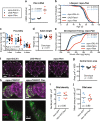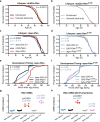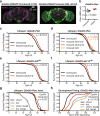Independent glial subtypes delay development and extend healthy lifespan upon reduced insulin-PI3K signalling
- PMID: 32928209
- PMCID: PMC7490873
- DOI: 10.1186/s12915-020-00854-9
Independent glial subtypes delay development and extend healthy lifespan upon reduced insulin-PI3K signalling
Abstract
Background: The increasing age of global populations highlights the urgent need to understand the biological underpinnings of ageing. To this end, inhibition of the insulin/insulin-like signalling (IIS) pathway can extend healthy lifespan in diverse animal species, but with trade-offs including delayed development. It is possible that distinct cell types underlie effects on development and ageing; cell-type-specific strategies could therefore potentially avoid negative trade-offs when targeting diseases of ageing, including prevalent neurodegenerative diseases. The highly conserved diversity of neuronal and non-neuronal (glial) cell types in the Drosophila nervous system makes it an attractive system to address this possibility. We have thus investigated whether IIS in distinct glial cell populations differentially modulates development and lifespan in Drosophila.
Results: We report here that glia-specific IIS inhibition, using several genetic means, delays development while extending healthy lifespan. The effects on lifespan can be recapitulated by adult-onset IIS inhibition, whereas developmental IIS inhibition is dispensable for modulation of lifespan. Notably, the effects we observe on both lifespan and development act through the PI3K branch of the IIS pathway and are dependent on the transcription factor FOXO. Finally, IIS inhibition in several glial subtypes can delay development without extending lifespan, whereas the same manipulations in astrocyte-like glia alone are sufficient to extend lifespan without altering developmental timing.
Conclusions: These findings reveal a role for distinct glial subpopulations in the organism-wide modulation of development and lifespan, with IIS in astrocyte-like glia contributing to lifespan modulation but not to developmental timing. Our results enable a more complete picture of the cell-type-specific effects of the IIS network, a pathway whose evolutionary conservation in humans make it tractable for therapeutic interventions. Our findings therefore underscore the necessity for cell-type-specific strategies to optimise interventions for the diseases of ageing.
Keywords: Ageing; Astrocytes; Glia; Insulin signalling; Lifespan.
Conflict of interest statement
The authors declare that they have no competing interests.
Figures




Similar articles
-
Cell type-specific modulation of healthspan by Forkhead family transcription factors in the nervous system.Proc Natl Acad Sci U S A. 2021 Feb 23;118(8):e2011491118. doi: 10.1073/pnas.2011491118. Proc Natl Acad Sci U S A. 2021. PMID: 33593901 Free PMC article.
-
The Drosophila insulin receptor independently modulates lifespan and locomotor senescence.PLoS One. 2015 May 28;10(5):e0125312. doi: 10.1371/journal.pone.0125312. eCollection 2015. PLoS One. 2015. PMID: 26020640 Free PMC article.
-
Ageing in Drosophila: the role of the insulin/Igf and TOR signalling network.Exp Gerontol. 2011 May;46(5):376-81. doi: 10.1016/j.exger.2010.09.003. Epub 2010 Sep 16. Exp Gerontol. 2011. PMID: 20849947 Free PMC article. Review.
-
Insulin/IGF-like signalling, the central nervous system and aging.Biochem J. 2009 Feb 15;418(1):1-12. doi: 10.1042/BJ20082102. Biochem J. 2009. PMID: 19159343 Review.
-
Role of insulin-like signalling in Drosophila lifespan.Trends Biochem Sci. 2007 Apr;32(4):180-8. doi: 10.1016/j.tibs.2007.02.007. Epub 2007 Apr 6. Trends Biochem Sci. 2007. PMID: 17412594 Review.
Cited by
-
Dysregulation of BMP, Wnt, and Insulin Signaling in Fragile X Syndrome.Front Cell Dev Biol. 2022 Jul 6;10:934662. doi: 10.3389/fcell.2022.934662. eCollection 2022. Front Cell Dev Biol. 2022. PMID: 35880195 Free PMC article. Review.
-
FoxO3 deficiency in cortical astrocytes leads to impaired lipid metabolism and aggravated amyloid pathology.Aging Cell. 2021 Aug;20(8):e13432. doi: 10.1111/acel.13432. Epub 2021 Jul 11. Aging Cell. 2021. PMID: 34247441 Free PMC article.
-
Role of FoxO transcription factors in aging and age-related metabolic and neurodegenerative diseases.Cell Biosci. 2021 Nov 2;11(1):188. doi: 10.1186/s13578-021-00700-7. Cell Biosci. 2021. PMID: 34727995 Free PMC article. Review.
-
Cell type-specific modulation of healthspan by Forkhead family transcription factors in the nervous system.Proc Natl Acad Sci U S A. 2021 Feb 23;118(8):e2011491118. doi: 10.1073/pnas.2011491118. Proc Natl Acad Sci U S A. 2021. PMID: 33593901 Free PMC article.
-
Bioorthogonal Stimulated Raman Scattering Imaging Uncovers Lipid Metabolic Dynamics in Drosophila Brain During Aging.GEN Biotechnol. 2023 Jun 1;2(3):247-261. doi: 10.1089/genbio.2023.0017. Epub 2023 Jun 19. GEN Biotechnol. 2023. PMID: 37363411 Free PMC article.
References
-
- Williams GC. Pleiotropy, natural selection, and the evolution of senescence. Evolution (N Y) 1957;11:398–411. doi: 10.1111/j.1558-5646.1957.tb02911.x. - DOI
Publication types
MeSH terms
Substances
Grants and funding
LinkOut - more resources
Full Text Sources
Medical
Molecular Biology Databases

